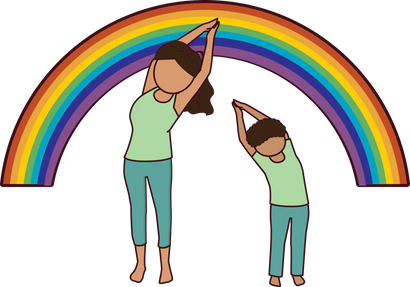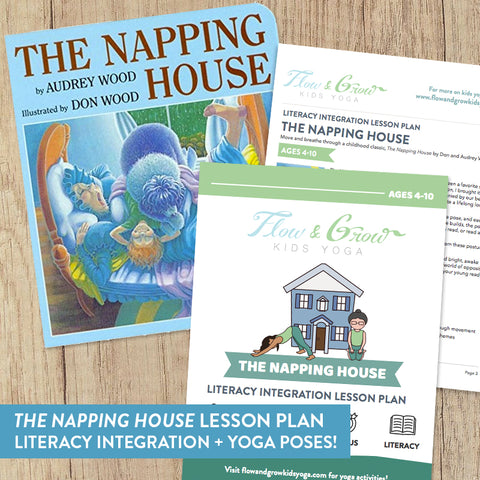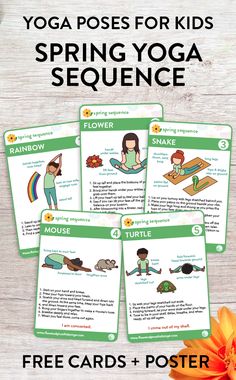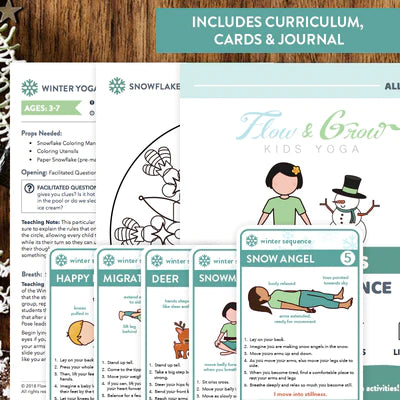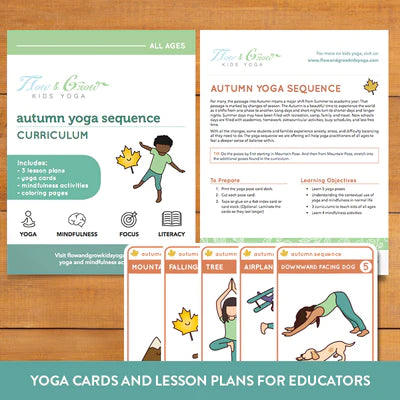Your Cart is Empty

How to design a literacy integration yoga class Re-release 2023
by Lara Hocheiser January 12, 2023 5 min read
Yoga literacy integration lesson plans have an number of benefits. Create literacy integrated yoga lessons easily.
What is yoga literacy integration?
A yoga class that integrates a story or book into the lesson plan is considered a yoga literacy integration.
To do a yoga integrated story lesson, no fancy, expensive materials are required (as much as we love kids' yoga props and tools!) These classes can be a uniquely effective way to expand literacy skills in students through engaging their bodies.
Further, you can hone the class to fit the age group, literacy levels, yoga experience, and physical capabilities of the students in front of you. Ultimately, there's the wonderful potential to foster greater love for both reading and yoga in your students.
And these classes can be held virtually or socially-distanced in-person. Let's look at how to design one of these classes!

-
Step 1 -- Choose your book
Go to your personal children's book library or the children's books section at your local library. You can even find fairly inexpensive gently used children's books online.
If you want to make an investment in a book you might use for many classes, you can also get certain new children's books without breaking the bank. You can also support local bookstores, if they're open at this time; due to COVID, small businesses could use the support right now!
Next, consider age group. Most children's books have an age range on the back cover of the book, yet that's an estimated range; your particular students might need a reading level up or down.
Then consider the illustration. Do the images appeal to you aesthetically? Do they think they'd appeal to your students? Can you, at first glance, think of at least a few yoga poses that could align with the story and illustrations, or at least see the potential for you to be creative and think of some?
The Napping House Literacy Integration Lesson Plan
-
Step 2 -- Create your warm-up
Once you have your book, it's time to start designing a well-rounded, enjoyable class.
A kids yoga warm-up is important to prepare students' bodies, minds, and social-emotional selves for class.
Begin with a connecting activity, such as children in the group passing a stress squeeze ball and saying their names and something fun about themselves, or even just everyone taking three breaths together.
Next focus on breath, using imagery such as in "Elevator Breath" or using a breathing ball -- so that children will center in their breath and will be more likely to bring it into the rest of class (and beyond!).
Following that is poses and movement flows to get the body ready to execute the poses in your literacy integration, safely and in an integrated, balanced way. Try Cat/Cow, backbends and forward bends from seated (you can pair this with imagery such as a flower opening and closing), "Kite" side bends, and clapping rhythms (on the floor, overhead, or body percussion) to further build student connection and engagement.
This section of class should be no more than three to five minutes for preschool-aged students, but could get longer for older students (up to ten minutes for older elementary children, for example).
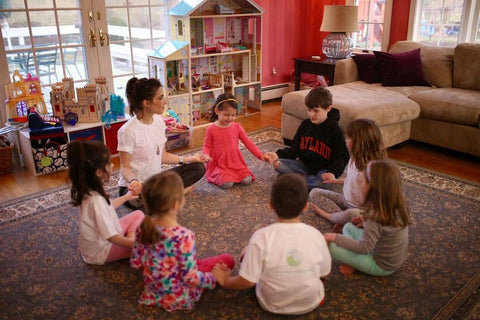
-
Step 3 -- Design your literacy integration!
Look again through the pages of the book, more slowly and carefully than you might have when you were browsing through to choose your book.
Think about what poses align with the story and the illustrations, at different points in the book. For instance, Falling Leaf, Tree Pose, and Kite Pose can fit in different places in The Giving Tree. Sea-themed poses like Starfish Pose, Shark Pose, and Crab Pose can work well with The Rainbow Fish.
Lion's Pose, Downward Facing-Dog, and Boat Pose can fit well with Where the Wild Things Are.
Above all, keep in mind the particular children who you will be teaching (if you've taught them before, and if you haven't, with whatever information that you can gather on them) as you design your yoga literacy integration.
For example, consider aspects such as their typical ability to stay focused on the lesson at hand (and what you can do to redirect them), poses they're mentally and physically able to execute in a calm and integrated manner, and how you can find the balance of challenging them while also allowing them to feel success.
If possible, for a cohesive feel to the class, rise to an energetic peak and then come back down and to calmer and less physically rigorous poses (with one or two peaks within your literacy integration lesson).
The Napping House Literacy Integration Lesson Plan
-
Step 4 -- Create your cool-down
Next, it's time for student's to calm their minds and bodies. You can also gather feedback on what they learned, and leave them in calm, collected place to bring into the rest of their days.
After the literacy integration, have students sit and take a few calm, collected breaths together. There are multiple ways to recap and get feedback about your students' feedback.
One such practice, you can bring the stress squeeze ball back and have each person share a word or two about what the class was like for them (or more, if you have time in the class) -- what was challenging, what was interesting, what they learned, what they liked, et cetera.
Another cool down practice, particularly if you have students in your class on the shyer side, you can ask if anyone wants to share a word or two, or more, about what they liked or what was challenging for them, et cetera. Then it's time to bring your students through a silent mindful rest or guided meditation -- in a traditional Savasana shape or another shape that feels right for them.
With preschool-aged children, this can even be a few short breaths together and perhaps a few affirmations -- "I am calm", "I am strong", "I am kind", et cetera.
For a silent mindful rest or guided meditation, a good guideline is one minute per half-year of life, but adjust that to your students as necessary. When you see them begin to stir, after they've already dropped into the rest, it's time to wrap it up and close your class. A nice class closing phrase is "I think kind thoughts. I speak kind words. I have a kind heart."sequence, and/or just take a few breaths together.

Benefits of Literacy Integration Yoga Classes for Kids
- instill a love of reading and story telling
- help children create a mind-body connection
- find new ways to re-visits favorite stories
- integrate the lessons of yoga philosophy or other lessons from the stories in your yoga class
- by warming up, moving through the main poses with the story, and cooling down, teach and embody the beginning, middle, and end to children
- learn yoga poses
- improve attention
- share joy
Enjoy a yoga for literacy video
Another great resource: The "I Am" series by Susan Verde. Here is a music video accompanying her book "I Am Yoga."
Leave a comment
Comments will be approved before showing up.
Also in Kids Yoga Blog

Easter Yoga Poses for Kids: Joy and Wellness to the Holiday Season
by Lara Hocheiser April 04, 2024 4 min read

Multifaceted Health Benefits of Yoga for Kids
by Lara Hocheiser February 04, 2024 3 min read
Yoga for kids has a transformative power! Holistic practices can enhance mental health, concentration, and physical fitness.

Learn to Teach Kids Yoga Training - Fall 2024
by Lara Hocheiser January 25, 2024 1 min read
In Fall 2024, you will learn how to teach kids yoga. Help empower young minds by learning evidence-based techniques.
Yamas and Niyamas: Successful Relationships with Self & Others (tweens and teens)
digital-resourceskids-yoga-resourceslesson-plansmiddle-high-school-yoga-mindfulnessmindfulnesspricey-content
Yamas and Niyamas: Successful Relationships with Self & Others (tweens and teens)
2 reviews
5.0 / 5.0
(2) 2 total reviews
$55.00
Yamas and Niyamas: Successful Relationships with Self & Others (tweens and teens)
2 reviews
5.0 / 5.0
(2) 2 total reviews
$55.00
Ultimate Kids Year of Yoga Bundle
bundlesdigital-resourcesearly-childhood-yoga-mindfulnesselementary-yoga-mindfulnesskids-yoga-resourcesmiddle-high-school-yoga-mindfulnesspricey-contentseasonal-yogayoga-cards
Ultimate Kids Year of Yoga Bundle
5 reviews
5.0 / 5.0
(5) 5 total reviews
$45.00
Ultimate Kids Year of Yoga Bundle
5 reviews
5.0 / 5.0
(5) 5 total reviews
$45.00
Kid’s Sun Salutation Yoga Cards
digital-resourcesearly-childhood-yoga-mindfulnesselementary-yoga-mindfulnesskids-yoga-resourcesliteracyunder-15yoga-cards
Kid’s Sun Salutation Yoga Cards
3 reviews
4.33 / 5.0
(3) 3 total reviews
$12.95
Kid’s Sun Salutation Yoga Cards
3 reviews
4.33 / 5.0
(3) 3 total reviews
$12.95
